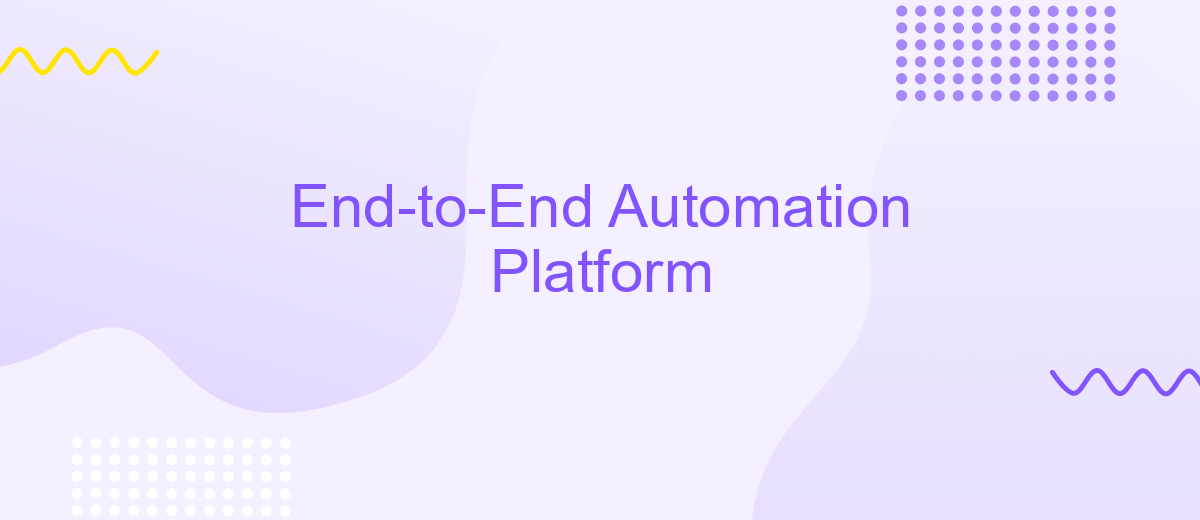End-to-End Automation Platform
In today's fast-paced digital landscape, businesses are increasingly seeking ways to streamline operations and enhance efficiency. An End-to-End Automation Platform offers a comprehensive solution by seamlessly integrating various processes, from data collection to analysis and execution. This holistic approach not only reduces manual intervention but also accelerates workflows, ensuring that organizations remain competitive and agile in an ever-evolving market.
Introduction: The Need for End-to-End Automation
In today's rapidly evolving digital landscape, businesses are under immense pressure to streamline operations and enhance productivity. The demand for efficiency and accuracy has never been higher, driving organizations to explore innovative solutions. End-to-end automation platforms have emerged as a vital tool for companies aiming to optimize their processes from start to finish. By automating repetitive tasks and integrating disparate systems, these platforms enable businesses to focus on growth and innovation.
- Reduces human error by automating manual tasks
- Improves operational efficiency across various departments
- Facilitates seamless integration of different software systems
- Enhances data accuracy and decision-making capabilities
- Frees up valuable human resources for strategic initiatives
As organizations continue to face challenges in maintaining competitiveness, the adoption of end-to-end automation becomes crucial. It not only helps in reducing costs but also in delivering consistent quality and faster time-to-market. By embracing these platforms, companies are better equipped to adapt to changing market demands and technological advancements, ensuring long-term success and sustainability in a dynamic business environment.
Key Features of an End-to-End Automation Platform

An End-to-End Automation Platform is designed to streamline and optimize business processes by providing a comprehensive suite of tools that automate tasks from start to finish. Key features of such a platform include robust workflow automation capabilities, enabling users to design, execute, and monitor complex workflows without the need for extensive coding knowledge. These platforms often offer drag-and-drop interfaces, making it easy for users to create customized automation solutions tailored to their specific business needs.
Another critical feature is seamless integration with a wide range of apps and services. Platforms like ApiX-Drive facilitate this by allowing users to connect different systems, ensuring smooth data flow and communication across various applications. This integration capability is essential for businesses looking to unify their operations and enhance productivity. Additionally, advanced analytics and reporting tools are typically included, providing users with valuable insights into their automated processes, helping them to identify areas for improvement and optimize performance continuously.
Benefits of Implementing an End-to-End Automation Platform

Implementing an end-to-end automation platform can significantly enhance business operations by streamlining processes and reducing manual intervention. This comprehensive approach not only improves efficiency but also minimizes the risk of human error, leading to more reliable outcomes. By integrating various tools and systems into a single cohesive platform, organizations can achieve seamless workflow automation, thus allowing employees to focus on more strategic tasks and innovation.
- Increased Efficiency: Automation accelerates processes, reducing time spent on repetitive tasks and enabling faster project completion.
- Cost Savings: By minimizing manual labor and optimizing resource allocation, businesses can significantly cut operational costs.
- Scalability: An end-to-end platform can easily adapt to growing business needs, supporting expansion without additional complexities.
- Improved Accuracy: Automation reduces the likelihood of human errors, enhancing data accuracy and decision-making processes.
- Enhanced Collaboration: Centralized systems facilitate better communication and coordination among teams, fostering a collaborative work environment.
Ultimately, adopting an end-to-end automation platform empowers businesses to remain competitive in a rapidly evolving digital landscape. By leveraging automation, organizations can drive innovation, improve customer satisfaction, and achieve long-term growth. As technology continues to advance, those who embrace comprehensive automation solutions will be better positioned to capitalize on new opportunities and navigate industry challenges effectively.
Choosing the Right End-to-End Automation Platform for Your Business

Choosing the right end-to-end automation platform for your business is a crucial decision that can significantly impact your operational efficiency and scalability. With numerous options available, it's essential to consider factors that align with your unique business needs and goals. Start by evaluating your current processes and identifying areas where automation can bring the most value.
Next, assess the platform's compatibility with your existing systems and its ability to integrate seamlessly with other tools you use. This ensures a smooth transition and maximizes the benefits of automation. Additionally, consider the platform's scalability to accommodate your business's growth and evolving requirements.
- Evaluate user-friendliness and ease of implementation.
- Check for robust support and training resources.
- Consider cost-effectiveness and return on investment.
- Ensure security and compliance with industry standards.
Ultimately, the right end-to-end automation platform should empower your business to streamline operations, reduce manual errors, and enhance productivity. By carefully considering these factors, you can make an informed decision that aligns with your strategic objectives and supports your long-term success.
- Automate the work of an online store or landing
- Empower through integration
- Don't spend money on programmers and integrators
- Save time by automating routine tasks
Conclusion: Embracing the Future with End-to-End Automation
As we stand on the brink of a new era in technology, embracing end-to-end automation is no longer a choice but a necessity. This transformative approach promises unprecedented efficiency, cost savings, and the ability to innovate at a pace previously unimaginable. By integrating automated solutions into every facet of business operations, companies can streamline processes, reduce human error, and focus more on strategic growth initiatives. The future of business lies in the seamless integration of these automated systems, ensuring that organizations remain competitive in an ever-evolving market landscape.
Moreover, platforms like ApiX-Drive play a crucial role in this automation journey by simplifying the integration process. They enable businesses to connect disparate systems and applications effortlessly, ensuring a smooth flow of data and operations. As companies continue to adopt end-to-end automation, tools that facilitate easy and effective integration will be indispensable. By leveraging these technologies, businesses can not only enhance their operational efficiency but also unlock new opportunities for innovation and growth. Embracing this future is about more than just technology; it's about redefining the way we work and create value.
FAQ
What is an End-to-End Automation Platform?
How can an End-to-End Automation Platform benefit my business?
What types of processes can be automated with an End-to-End Automation Platform?
How do I integrate my existing systems with an End-to-End Automation Platform?
Is technical expertise required to implement an End-to-End Automation Platform?
Time is the most valuable resource in today's business realities. By eliminating the routine from work processes, you will get more opportunities to implement the most daring plans and ideas. Choose – you can continue to waste time, money and nerves on inefficient solutions, or you can use ApiX-Drive, automating work processes and achieving results with minimal investment of money, effort and human resources.


